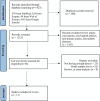Computed tomography pulmonary angiography (CTPA) for the detection of pulmonary embolism (PE) among trauma patients: a systematic review and meta-analysis
- PMID: 38844660
- PMCID: PMC11289063
- DOI: 10.1007/s10140-024-02249-7
Computed tomography pulmonary angiography (CTPA) for the detection of pulmonary embolism (PE) among trauma patients: a systematic review and meta-analysis
Abstract
Background and objectives: Computed tomography pulmonary angiography (CTPA) is a standard imaging technique employed for the detection of pulmonary embolism (PE). This systematic review and meta-analysis aims to examine the prevalence of PE among the trauma patients undergoing CTPA.
Methods: A comprehensive search across PubMed, Scopus, Google Scholar, and Web of Science yielded 13 studies encompassing 5,570 individuals conducted following Preferred Reporting Items for Systematic Review and Meta-Analysis (PRISMA) guideline. Studies that used CTPA for the detection of PE among the trauma patients were selected. This resulted in an evaluation of prevalence, trauma types, clinical manifestations, radiological findings, and mortality rates of PE among traumatic patients undergoing CTPA.
Results: The overall prevalence of PE among trauma patients undergoing CTPA was 18% (95% CI = 13-24%). After pooling the existing data, femur fractures were determined to be the most prevalent trauma type (12%). The most prevalent clinical manifestations of PE among trauma patients included shortness of breath, chest pain, and altered vital signs. Radiological findings encompassed various pulmonary abnormalities, such as opacity, ground-glass opacities, and pleural effusions. Mortality rates of PE among the trauma patients ranged from 0% to 29.4% across the included studies.
Conclusion: This study provides comprehensive insights into the prevalence, clinical manifestations, radiological findings and mortality of PE among trauma patients undergoing CTPA. According to our findings, lower threshold for CTPA is recommended in patients with lower extremity or spine fractures.
Keywords: Computed tomography pulmonary angiography; Meta-analysis; Prevalence; Pulmonary embolism; Systematic review; Trauma patients.
© 2024. The Author(s).
Conflict of interest statement
All authors confirm they have no competing interests.
Figures



Similar articles
-
The Current State of Artificial Intelligence on Detecting Pulmonary Embolism via Computerised Tomography Pulmonary Angiogram: A Systematic Review.Br J Hosp Med (Lond). 2025 Jun 25;86(6):1-21. doi: 10.12968/hmed.2024.0757. Epub 2025 Jun 5. Br J Hosp Med (Lond). 2025. PMID: 40554436
-
Safety of ruling out acute pulmonary embolism by normal computed tomography pulmonary angiography in patients with an indication for computed tomography: systematic review and meta-analysis.J Thromb Haemost. 2009 Sep;7(9):1491-8. doi: 10.1111/j.1538-7836.2009.03518.x. Epub 2009 Jun 22. J Thromb Haemost. 2009. PMID: 19552684
-
The diagnostic performance of CT pulmonary angiography in the detection of chronic thromboembolic pulmonary hypertension-systematic review and meta-analysis.Eur Radiol. 2022 Nov;32(11):7927-7935. doi: 10.1007/s00330-022-08804-5. Epub 2022 Apr 28. Eur Radiol. 2022. PMID: 35482124
-
Imaging for the exclusion of pulmonary embolism in pregnancy.Cochrane Database Syst Rev. 2017 Jan 26;1(1):CD011053. doi: 10.1002/14651858.CD011053.pub2. Cochrane Database Syst Rev. 2017. PMID: 28124411 Free PMC article.
-
Diagnostic accuracy of lung ultrasound for pulmonary embolism: a systematic review and meta-analysis.J Thromb Haemost. 2013 Jul;11(7):1269-78. doi: 10.1111/jth.12232. J Thromb Haemost. 2013. PMID: 23574640
References
-
- Wells PS et al (2000) Derivation of a simple clinical model to categorize patients probability of pulmonary embolism: increasing the models utility with the SimpliRED D-dimer. Thrombosis and haemostasis. 83(03):416–420 - PubMed
Publication types
MeSH terms
LinkOut - more resources
Full Text Sources
Medical

